|
The largest event ever to take place at Antietam Battlefield, with the exception of the battle itself, was in 1924. In September of that year, 3,200 United States Marines marched from their base in Quantico, Virginia to Sharpsburg and spent eleven days on the battlefield. In addition to training and maneuvers, the “soldiers of the sea” held baseball games, concerts, parades, ceremonies, movies and dances. They brought tanks, aircraft, balloons, machine guns, artillery, trucks and all the equipment needed for a major deployment. Photographs of the event appeared in papers across the county. Over 100,000 people came out during the event to witness the spectacle.
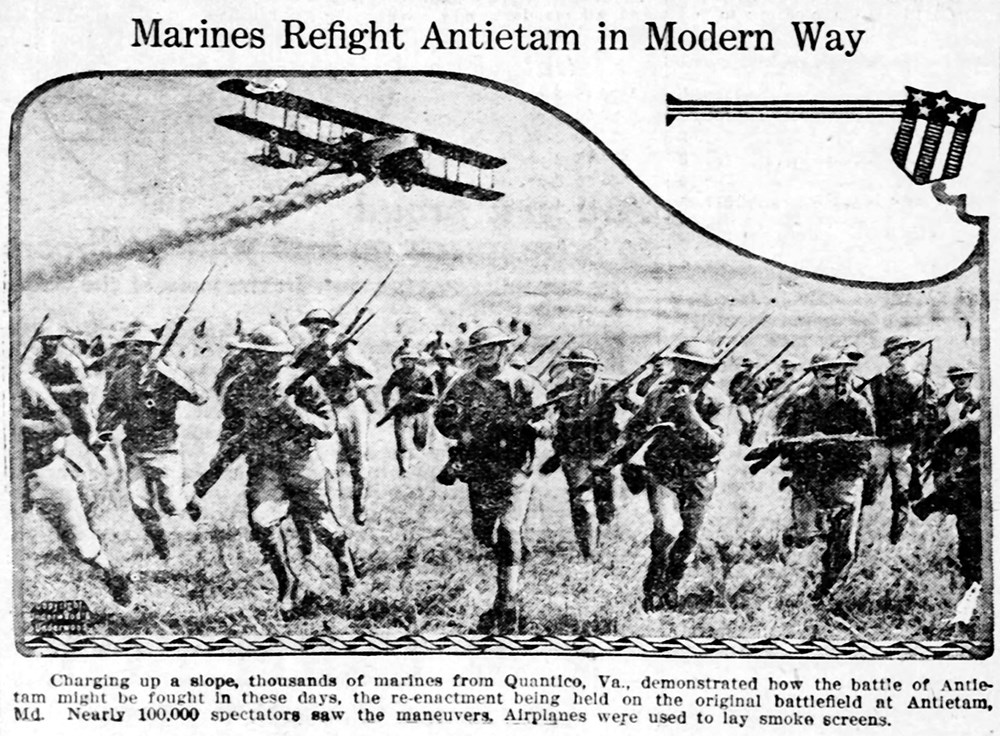
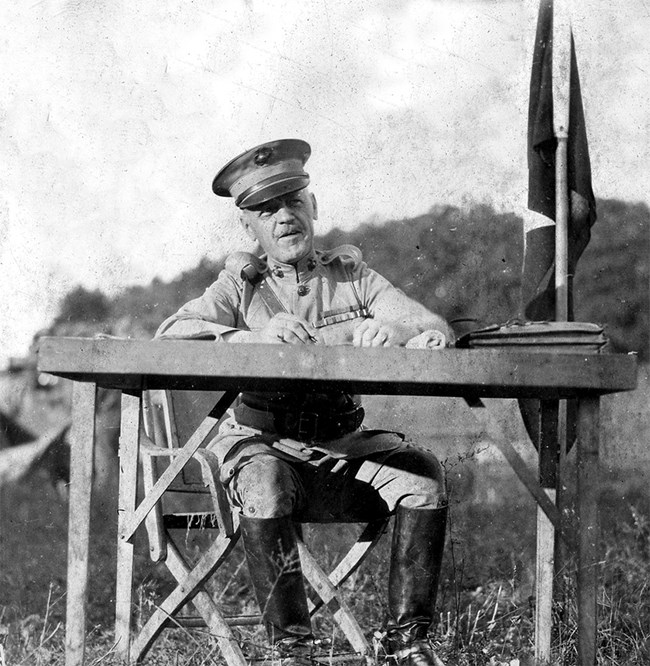
General Dion Williams, circa 1924 From the Joseph B. Knotts Collection (COLL/372) at the Archives Branch, Marine Corps History Division The Fall Exercises, 1924 booklet that was issued to every Marine who participated, stated that their purpose was to “demonstrate with personnel and material of the Force how an attack would be conducted under present day conditions upon the Civil War Battlefield of Antietam,” while at the same time “furnish a spectacular feature for the observers and visitors who will be invited.” The training order for this event specifically stated the demonstrations were valuable for “publicity and advertising,” while also providing experiences that will “accustom the personnel to marching conditions, familiarize them with the routine and technique of campaign and subsistence for a period away from the barracks, and give opportunity for exercises of all arms over diversified ground in unknown territory.” 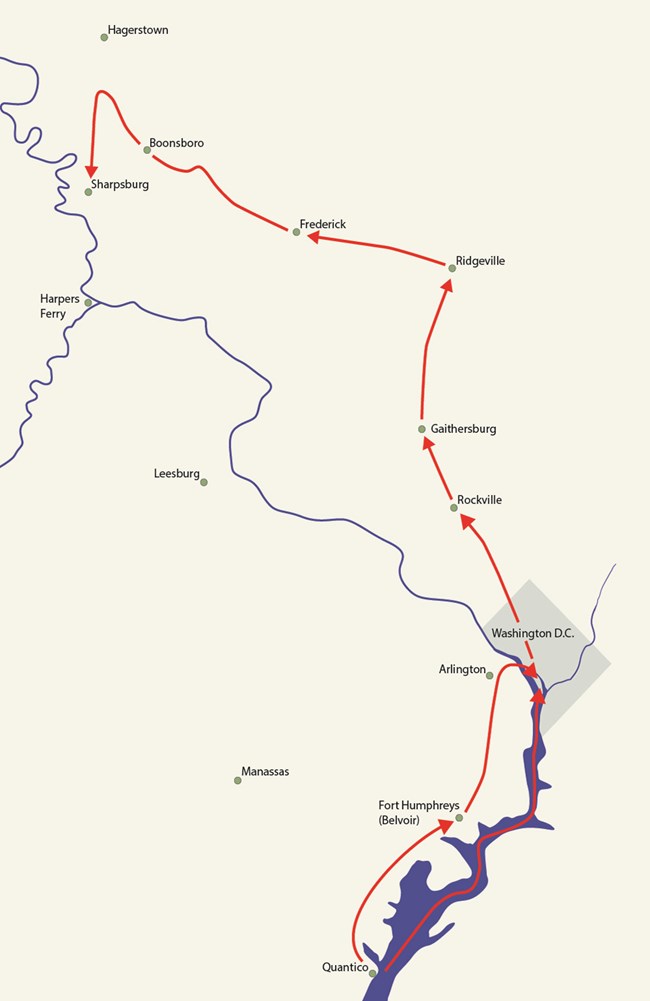
National Park Service August 30 was a big day for the Marines and the city of Frederick. It started with a parade and review at 10:00 am. At noon, Marine aviation staged a dramatic aerial battle over the city. The camps were open to the public all day, and that night the Marine Band performed a concert and there were two dances – one for the officers at the Catoctin Country Club, and a separate dance for the enlisted at the Armory. 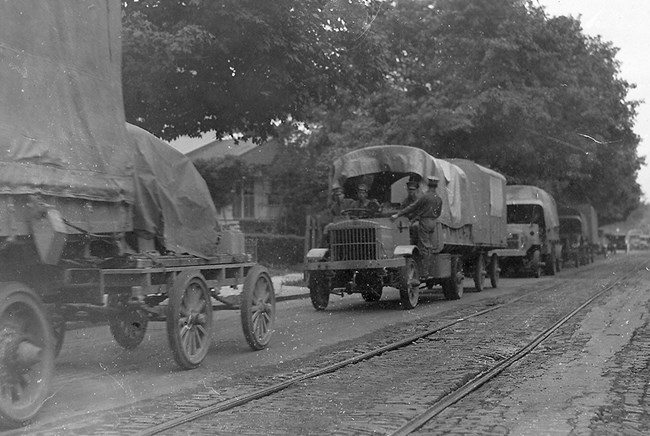
Antietam Reenactment Photo Collection, Historical Resources Branch, Marine Corps History Division, Quantico Virginia Finally, after six days of travel and a day of liberty, the Marines arrived on the battlefield, setting up their camp on the historic Piper Farm. The next eleven days were filled with drill, parades, more drill, night searchlight training, and field exercises, all building to the final demonstration of a regimental-sized attack. Important dignitaries attended that week, including the Commandant of the Marine Corps Lieutenant General John Archer Lejeune, Smedley Darlington Butler and Theodore Roosevelt Jr. 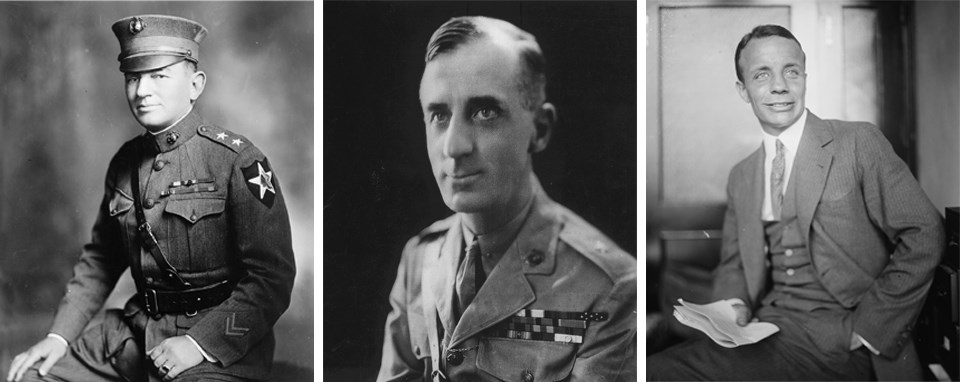
Library of Congress, Marine Corps Archives & Special Collections Theodore Roosevelt Jr. was a government, business, and military leader. During WW I he commanded the 26th Infantry Regiment as a Lieutenant Colonel. After the war, Roosevelt was instrumental in the formation of the American Legion. He served as a New York State Assemblyman and was the Assistant Secretary of the Navy during this event. Roosevelt also served as Governor of Puerto Rico and Governor General of the Philippines, Chairman of the Board of the American Express Company and Vice-President at Doubleday Books. During World War II he was promoted to Brigadier General, assistant division commander of the 1st Infantry Division. At the age of 56, he landed on D-Day with the first elements at Utah Beach. General Omar Bradley described Roosevelt’s valor as the “single greatest act of courage” he witnessed in the entire war. He died of a heart attack a month later and was awarded the Medal of Honor for his actions on the beachhead.
In addition to the dignitaries, visitors poured in from all around the region. One local paper’s headline read “Shepherdstown is Agog over Marines.” The article told how, “the camp of the United States Marines on Antietam Battlefield at Sharpsburg attracts large crowds of people each day. Last Sunday many thousands of visitors were present, and the roads leading to Sharpsburg were congested by the greatest automobile traffic that section has ever known.” The Martinsburg Journal reported that “the fields were full and all the streets in Sharpsburg were jammed with cars.” Visitors “swarmed down on the guides to the battlefield and went around the well-worn paths to the spots of historic interest in small armies . . . Tourists were ubiquitous.” 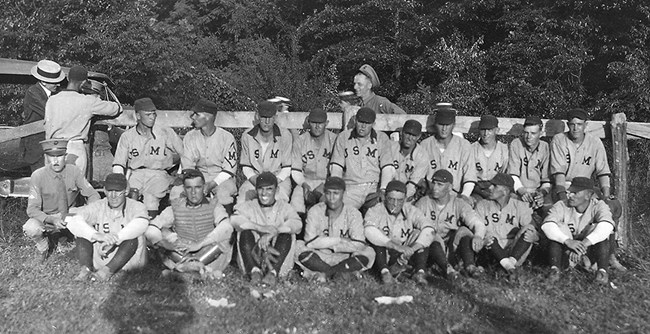
Antietam Reenactment Photo Collection, Historical Resources Branch, Marine Corps History Division, Quantico Virginia 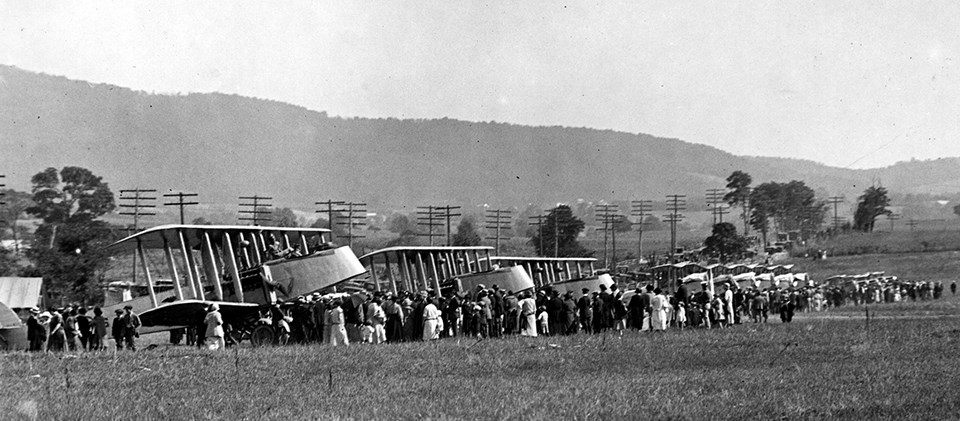
Antietam Reenactment Photo Collection, Historical Resources Branch, Marine Corps History Division, Quantico Virginia 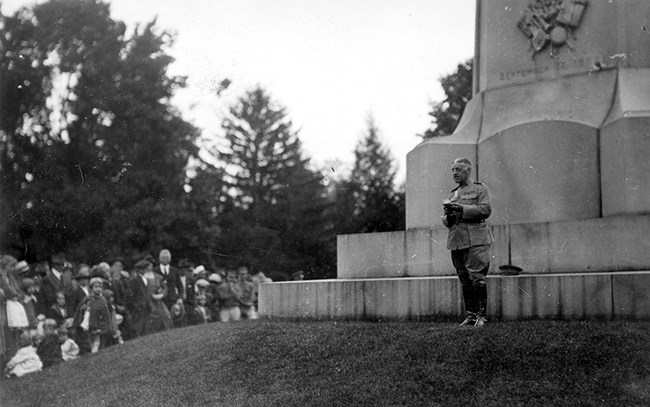
Antietam Reenactment Photo Collection, Historical Resources Branch, Marine Corps History Division, Quantico Virginia 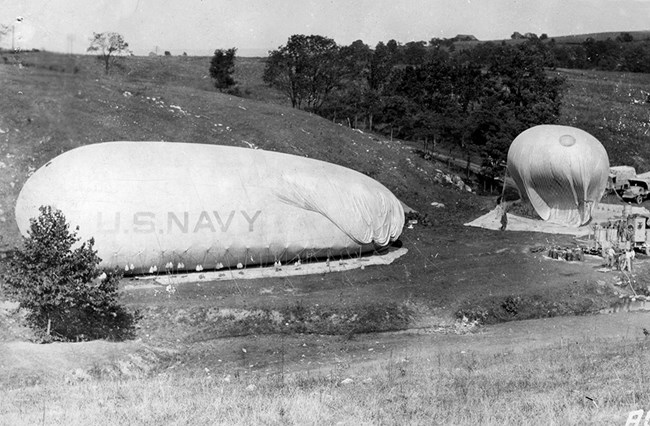
Antietam Reenactment Photo Collection, Historical Resources Branch, Marine Corps History Division, Quantico Virginia
All of these events were just a prelude to the big day. Friday, September 12 was the full demonstration of the entire force. Unlike other reenactments on former Civil War battlefields, the Antietam event was purposely planned to be a modern battle. The Gettysburg Times reported that “60,000 men and women came here yesterday to see for the first time the battle of Antietam—resurrected, rejuvenated and staged by the United States Marines with all modern war paraphernalia…It was the largest crowd assembled here since that September day in 1862” The crowd witnessed, “a model offensive drive over the same gently rolling hills of Civil War Antietam. The ground was the same, but that was all. Airplanes circled overhead and swooped down low to bomb the enemy lines. Artillery firing blank shrapnel laid down a barrage for advancing infantry. The infantry deployed and crept forward, while machine guns rattled on either flank. And finally, tanks scurried here and there, spitting fire and leveling positions. Thousands of automobiles dotting the hillsides like black beetles on a carpet of green and brown.”

Library of Congress, Marine Corps History Division 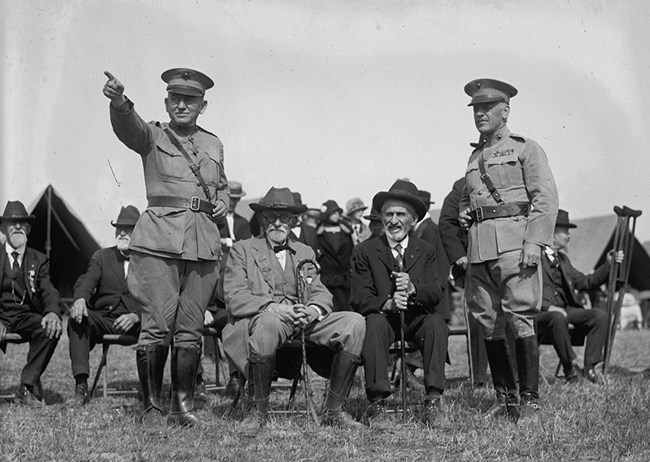
Library of Congress
This event was not just successful for the Marines, it was good for the local economy. Leatherneck Magazine stated that “the merchants were busy till a late hour last night catering to the needs of our troops in the front lines.” The roadways were lined with booths selling “iced drinks of every description, ranging from orangeade to coca cola.” Trucks piled with cantaloupes, fruit and other refreshments did a brisk business. The Standard Oil Company in Shepherdstown sold 13,000 gallons of gas for the Marine trucks and cars. Hundreds of brass cartridge shells were gathered by local children and sold as souvenirs, and the Shepherdstown Register announced, “All of the lumber used in the building of the officer’s tents will be sold at public auction to the highest bidder on Saturday, September 13, and is to be removed from the grounds within 24 hours unless arranged otherwise with Mr. Piper, the landowner.” That same day the Marines began their long journey back to Quantico with one more memorable stop. On the September 18 the footsore Marines marched across the south lawn of the White House for a parade and review by President Coolidge and his wife who stood on the south portico. 
Library of Congress
On September 22, 1924, the Marine Corps Commandant commended General Williams on the “precision and smoothness with which the Force functioned during these maneuvers, indicating a pains-taking preparation, an efficient staff system and a high degree of military training, which reflected great credit on Brigadier General Williams as Commanding General, and on the officers and men attached to the Force.” A week later the Preparedness Report from the Commanding General of the Marine Corps to the Secretary of the Navy stated that “On the whole, the 1924 Fall Maneuvers resulted in very valuable training and experience for the personnel of the Marine Corps who participated.” However, the Gettysburg Times had a much more dramatic review of the Marine battle at Antietam. “The scars left by that sanguinary and obstinate struggle on human hearts and on the peaceful earth have disappeared under the healing hand of time, but those who visit the old battlefield today will dwell more on the splendor of the tragedy and the great principles which underlay it than on the horrors that it witnessed. A great contrast this September 1924 to that of 1862. A united country, strong and peaceful now, free from internal conflict and fearless of foreign threat…We have reason to thank God that there are no foes at Sharpsburg today. Our gallant Marines are simply developing their strength for the protection of the country should such protection unhappily ever be needed.” The Baltimore Sun perfectly summarized the Marine’s fall event as “one of the most interesting and spectacular peace-time campaigns in the history of its existence as an organized force.” Today, the Marines and numerous other military groups from every branch of service still visit the park every year to study and experience the battlefield. However, their tanks and machine guns are no longer permitted. Note: quotes from newspaper accounts appear as published. | |||||||||||||||||||||||||||||||||
Last updated: April 7, 2020
